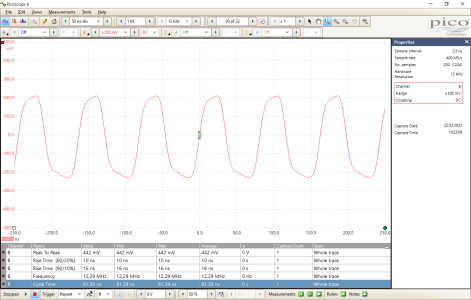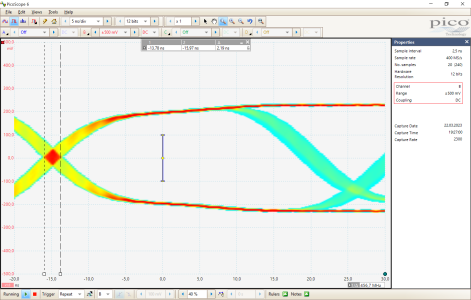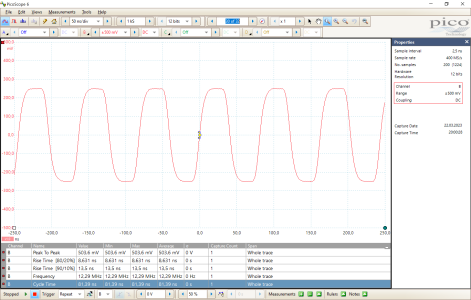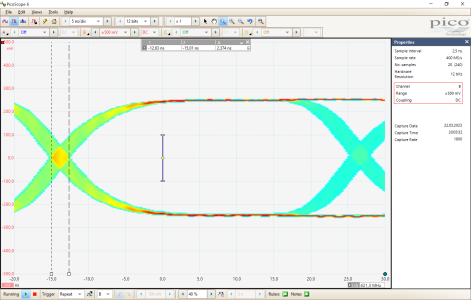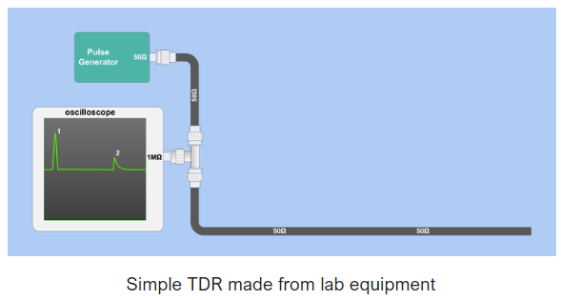Sure i'm wrong but i'm not shure that jitter can be directly related to eye pattern result.But I think the noise and jitter can be still observed on the pattern.
Coaxial SPDIF experiment
- Thread starter onlyoneme
- Start date
Why? Do you think the jitter is not visible on the eye pattern as a time deviation?Sure i'm wrong but i'm not shure that jitter can be directly related to eye pattern result.
a frequency loss itself shouldn't change eventually jitter issues, the frequency cutting effect has to be considered constant in a given system and if the frequency of signal is precise, there is no reason to worry about.Why? Do you think the jitter is not visible on the eye pattern as a time deviation?
Probably, impedance mismatch could lead a more random variation and a given voltage level on the input comparators be sensed at different time than requested.
I must admit that i have not specific experience.
Regarding audio analog cables, maybe impedance is never considered, due to low frequencies involved. Digital 50 or 75 Ohm cables, especially those from old 3270 IBM terminals i worked on '80ies, were always thicker an rigid...
Time for some conclusions after testing Pro's coax output and comparing with my spdif switch 
1. Pro has no isolation on the output. I've measured a DC offset from -5mV to -18 mV depending on the sample rate.
2. I've no idea if I was able to see a jitter. But I was able to see some amplitude distortions for sure. Details at the end.
3. A popular BJC coax cable seems to be 75 ohm indeed, or very close to that.
4. Measured rise time (10% to 90%) was about 15ns to 22ns. Not sure if it's a lot or not, my switch had more stable 13ns. As I know shorter rise time allows to use shorter cables but is also more demanding.
5. Pro's signal looks worse than the one from my switch in terms of visuals. It also seems to prefer longer 50 ohm cables than shorter ones 75 ohm.
It also has a strong Duty Cycle Distortion - an asymmetry in duration of "0" and "1" states. As I have read it can possibly affect a BER - Bit Error Rate - "the ratio of bits that have errors, compared to the overall bits".
1. Pro has no isolation on the output. I've measured a DC offset from -5mV to -18 mV depending on the sample rate.
2. I've no idea if I was able to see a jitter. But I was able to see some amplitude distortions for sure. Details at the end.
3. A popular BJC coax cable seems to be 75 ohm indeed, or very close to that.
4. Measured rise time (10% to 90%) was about 15ns to 22ns. Not sure if it's a lot or not, my switch had more stable 13ns. As I know shorter rise time allows to use shorter cables but is also more demanding.
5. Pro's signal looks worse than the one from my switch in terms of visuals. It also seems to prefer longer 50 ohm cables than shorter ones 75 ohm.
It also has a strong Duty Cycle Distortion - an asymmetry in duration of "0" and "1" states. As I have read it can possibly affect a BER - Bit Error Rate - "the ratio of bits that have errors, compared to the overall bits".
as far i remember the (terrible) signal shape on scope from late '70ies data tape reel units (IBM 3420), nothing too hard to manage by any dac input...
I believe that major problems derive from frequency variations rather than from the shape of the waveform, if this is constant.
Sure, better shape it's always better...
Did you measure directly with the dac input as load? I understand that this requires some work...
I believe that major problems derive from frequency variations rather than from the shape of the waveform, if this is constant.
Sure, better shape it's always better...
Did you measure directly with the dac input as load? I understand that this requires some work...
Last edited:
Yes, probably nothing to worry in case of any decent DAC, except no isolation and a DC offset. But when the Pro meets a DAC with its own issues like D50s, too long or too short cable, I can imagine that all those shape nuisances can start to be very important.as far i remember the (terrible) signal shape on scope from late '70ies data tape reel units (IBM 3420), nothing too hard to manage by any dac input...
I believe that major problems derive from frequency variations rather than from the shape of the waveform, if this is constant.
Sure, better shape it's always better...
Did you measure directly with the dac input as load? I understand that this requires some work...
My scope has a high impedance input so an additional terminator has been used. Not sure what a DAC as a load could change here.
think impedance in the case of the use of rca, which historically is an ultra chip format dedicated to the bf, and not bnc.. hardly makes sense..
the rca is not thought hf ..
(and moreover a shame when you then see the evolution since 40en towards the rca "" hdg "" audiophile ""etc etc .. funny)
Canare has made a special effort to make RCAs designed in a bnc way to avoid impedance breaks and comply with the 75ohm standard...but it's only for coaxial cable...
the rest..no comment
the rca is not thought hf ..
(and moreover a shame when you then see the evolution since 40en towards the rca "" hdg "" audiophile ""etc etc .. funny)
Canare has made a special effort to make RCAs designed in a bnc way to avoid impedance breaks and comply with the 75ohm standard...but it's only for coaxial cable...
the rest..no comment
BJC cables use Canare RCAP to be as close to 75 ohm as possible according to their declarations.think impedance in the case of the use of rca, which historically is an ultra chip format dedicated to the bf, and not bnc.. hardly makes sense..
the rca is not thought hf ..
(and moreover a shame when you then see the evolution since 40en towards the rca "" hdg "" audiophile ""etc etc .. funny)
Canare has made a special effort to make RCAs designed in a bnc way to avoid impedance breaks and comply with the 75ohm standard...but it's only for coaxial cable...
the rest..no comment
any dac should easily presents the correct impedance load, it's was just to verify the specific case...Not sure what a DAC as a load could change here.
like many others ..BJC cables use Canare RCAP to be as close to 75 ohm as possible according to their declarations.
it is a very professional approach in connector crimped on coaxial ..
(the bnc was an expensive hf connector from the 50s..
the rca, with din 5, just to tinker with the bf with a plastic connector costing nothing, on cable costing nothing, for general public equipment from the 60s-70s .. when you see the evolution .. it's funny)
will remain a bit relative if there are no design efforts on the connector on the device side..
;-)
but square in mhz.. we are really not in the nice world of bf 20-20k
;-)
A DAC should have a coax input impedance 75 ohm for rca or bnc. It can vary in practice especially for rca. But I guess that my terminator simply simulates a dac load with the specified impedance. Am I wrong here?any dac should easily presents the correct impedance load, it's was just to verify the specific case...
is the subject in the end it seems to me....
can be specialists in these frequent topics on this forum...???
of course, it's off with our modest approaches and our little wiim..
but..exciting
;-)
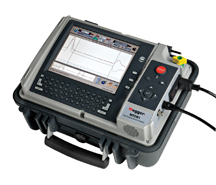
 en.wikipedia.org
en.wikipedia.org
can be specialists in these frequent topics on this forum...???
of course, it's off with our modest approaches and our little wiim..
but..exciting
;-)

Time-domain reflectometer - Wikipedia
on the main lines...
but it seems to me that it is a little more trivial.. and that precisely in our cases we must approach the subject with "our generators" very imperfect etc (we come across ugly 30-40ns like 2 or 3 ns risetime in our "domain" etc etc)
;-)
but far exceeds my skills.. I will leave it at that...
but I feel that it will fascinate you and your pico ;-)
and I don't even have a "wiim pro"
but it seems to me that it is a little more trivial.. and that precisely in our cases we must approach the subject with "our generators" very imperfect etc (we come across ugly 30-40ns like 2 or 3 ns risetime in our "domain" etc etc)
;-)
but far exceeds my skills.. I will leave it at that...
but I feel that it will fascinate you and your pico ;-)
and I don't even have a "wiim pro"
Last edited:
Definitely too much for me. No skills on my side, no real knowledge here, some basic equipment is not enough. I say stopon the main lines...
but it seems to me that it is a little more trivial.. and that precisely in our cases we must approach the subject with "our generators" very imperfect etc (we come across ugly 30-40ns like 2 or 3 ns risetime in our "domain" etc etc)
;-)
but far exceeds my skills.. I will leave it at that...
but I feel that it will fascinate you and your pico ;-)
and I don't even have a "wiim pro"
Similar threads
- Replies
- 664
- Views
- 54K
- Replies
- 350
- Views
- 56K
- Replies
- 15
- Views
- 3K
- Question
- Replies
- 20
- Views
- 4K






